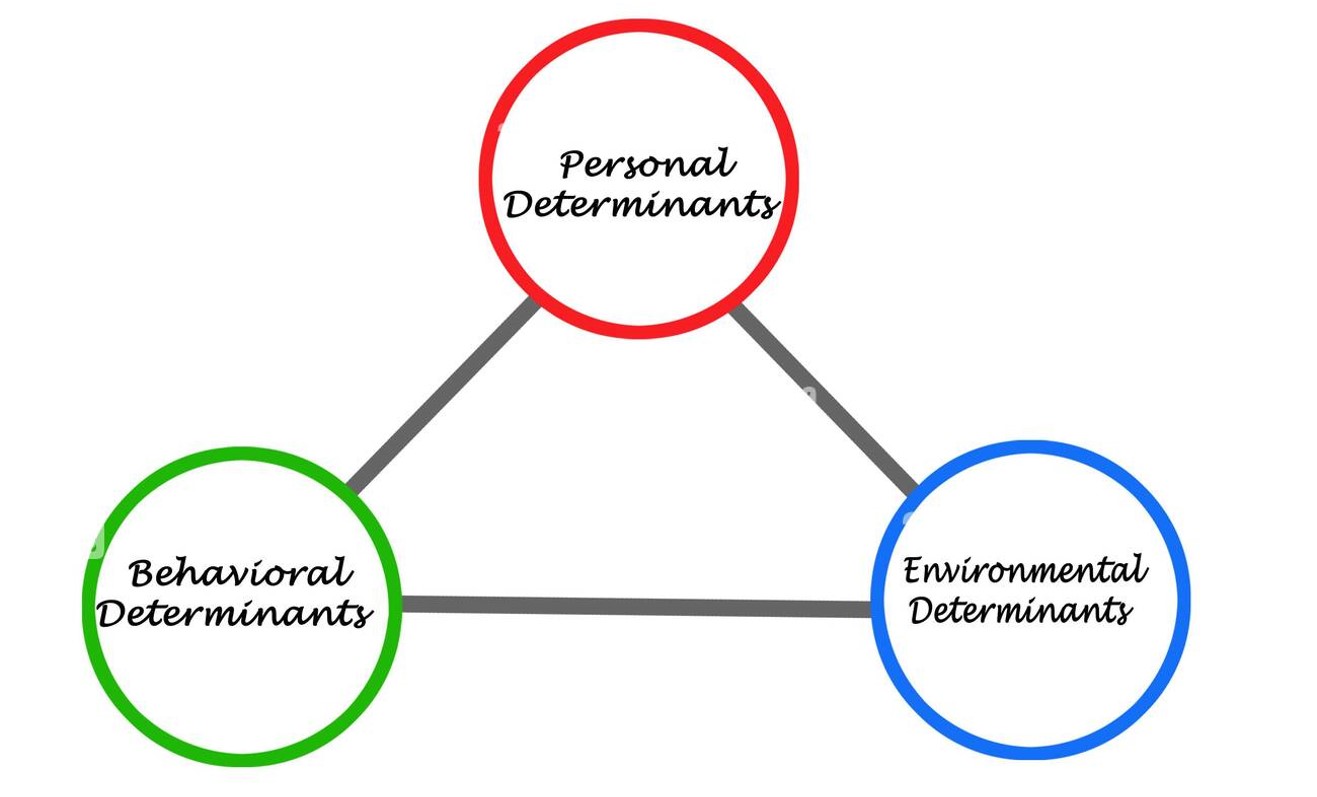Social Cognitive Theory
Social cognitive theory has its origins in psychology but is also involved in the fields of education, business, and applied health psychology. The essence of its foundation is learning theory. Bandura's early 'social learning theory' emphasized the demonstration of behavior through observing others being rewarded or punished (Bandura, 1977). He later identified the limitations of the basic behaviorist view and developed the 'Social Cognitive Theory', which extended social learning theory to include cognitive factors such as beliefs, self-perceptions, and expectations (Bandura, 1986). Unique to this theory is the focus on social influences and the emphasis on external and internal social reinforcement.
Social Cognitive Theory describes a system known as 'triadic interaction determinism', which refers to the dynamic interplay between three factors: the individual, the environment, and the behavior (Lo Schiavo et al., 2019). The theory's basic premise is that human activity is determined by the interaction of three factors: individual behavior, individual cognition, and other personal characteristics, and the external environment in which the individual lives. The interactions between these three factors do not occur simultaneously or with equal intensity; moreover, their mutual influence is not immediately apparent. It is only with time that the two-way influence of each factor comes into play. Based on this theoretical starting point, people are both the shapers and the products of their environment.

Figure 1. Bandura’s Model Reflecting SCT
Social cognitive theory has four main theoretical components: modeling, outcome expectations, self-efficacy, and identity. According to social cognitive theory, people can learn indirectly by observing the behavior of others (Bandura, 1997), which is an important part of the triadic relationship. To explain this idea, Bandura and his colleagues conducted a series of Bobo doll experiments. In the experiments, children were exposed to aggressive or non-aggressive models. They found that children exposed to aggressive models behaved more aggressively towards Bobo dolls and that boys were more likely to do so than girls (Bandura et al., 1961). Modeling is not, of course, limited to live demonstrations; verbal and written behavior can also be used as an indirect form of modeling. Modeling not only allows pupils to learn behaviors they should repeat, but it can also inhibit certain behaviors. For example, if a teacher glares at a student who speaks irregularly, other students may inhibit that behavior to avoid a similar response.
To learn a particular behavior, people must understand what the likely outcome will be if they repeat the behavior (Bandura, 1977). This expectation of a similar outcome when imitating the behavior is the outcome expectation. Because people anticipate the consequences of a behavior before they engage in it, these expectations influence whether someone succeeds in completing the behavior. It is influenced to a large extent by the environment in which a person is brought up. For example, in the United States, driving under the influence may result in a fine or jail time, but in El Salvador, it may result in the death penalty.
People's self-efficacy can affect their lives in many ways (Bandura & Wessels, 1994). For example, self-efficacy is a key factor in determining how people find and acquire new skills. In addition, people with high self-efficacy tend to focus on how to master the task at hand, while those with low self-efficacy tend to focus on what can go wrong. Self-efficacy also determines how hard people work and persevere in overcoming difficulties and accomplishing goals. The higher the self-efficacy, the more effort people put in and the more perseverance they have. The most effective way of creating a strong sense of efficacy is through mastery experiences (Bandura, 1977).
Finally, there is also a sense of identification. Identification makes the observer feel a one-to-one resemblance to the model and can therefore lead to a greater chance of the observer acting in accordance with the model (Bandura, 1988). People are more likely to follow the behavior imitated by someone they can identify with. The more commonalities or emotional connections between the observer and the model, the more likely the observer will learn and replicate the model's behavior (Bandura & Watts, 1996).
In summary, according to Bandura (1986), predictions about the likely outcomes of behavior play a key role in learning because they influence goal setting, effort, persistence, use of strategies, and resilience to learning. Self-efficacy refers to an individual's perception and judgment of their ability to solve a particular task effectively.